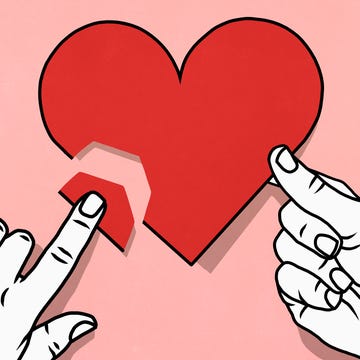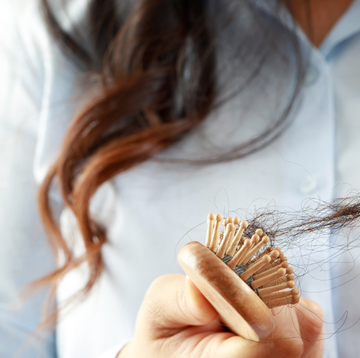If your crowning glory is looking a little less lustrous than it was, you’re in good company. Women may be much less prone than men to losing all their hair, but a visible scalp and thinning locks are by no means a male preserve. So why do women lose their hair, what treatments help – and which definitely don’t?
What's normal for hair growth?
Your hair is made up of protein and goes through three different ‘phases’ in its lifetime – the growing (anagen) phase, which lasts three to five years; the ‘shrinking’ (catagen) phase, for 10-14 days; and then the resting (telogen) phase, which lasts for about three months.
After this, the hair follicle hopefully enters a new growing phase and the whole process is repeated. Your individual hairs move between these phases at different times, so you lose 50-100 hairs a day.
What to read next
What causes hair loss?
There are many reasons why hair can start thinning. Significant body stresses, ranging from infections with high fever to sudden weight loss and major surgery, can put your hair prematurely into the resting telogen phase. This hair loss is usually not permanent and, with time, hair will regrow.
A different type of hair loss, anagen effluvium, is usually caused by chemotherapy, radiation or exposure to toxic heavy metals such as mercury or thallium. Hair growth at the follicle is disrupted, so the hair becomes narrow and susceptible to breaking off.
Then there’s alopecia areata, which causes patches of baldness or, in extreme cases, develops into alopecia totalis (all hair on the head) or alopecia universalis (all body hair).
This is the type of hair loss experienced by TV presenter Gail Porter. It’s an auto-immune condition, where part of your immune system turns against part of your body. In this case, T-cells from your immune system gather around the base of your hair follicles and attack them.
You can also develop traction alopecia, where hair is pulled out at the roots, caused by pulling it back repeatedly – for example, into hairstyles including a tight ponytail or bun.
But most commonly...
Hair loss in older women is due to age. We all know that our hair colour changes with age, as pigment cells stop producing colour as prolifically. But it’s also possible for the life cycle of your hair to shorten and your hair follicles to shrink as the years go by, so lost hair is replaced by finer, thinner hairs. Over time, the shed hair is not replaced. Female pattern hair loss affects about half of women over 65. It rarely results in complete or near-complete baldness, or a receding hairline. Instead, hair is often lost first from the crown, resulting in a wider parting – the so-called ‘Christmas-tree parting’.
It’s usually down to a combination of ageing, family history and hormonal changes, especially around the menopause. This can have a huge impact on your self-confidence and self-esteem – so it’s hardly surprising there’s a booming market in supplements, shampoos and other products that claim to boost hair growth.
Is it worth seeing my GP?
If you suddenly lose large quantities of hair, or if you’re losing patches of hair but have normal hair growth around them, it’s worth speaking to your doctor. They may recommend blood tests to rule out treatable causes.
Hair shedding can be a sign of iron deficiency, even if it’s not severe enough to cause anaemia – a full blood count and ferritin test will check your iron stores. Likewise, an underactive thyroid gland can lead to thinning hair: other symptoms include putting on weight without eating more, tiredness, constipation and feeling the cold. Vitamin D deficiency could also be a culprit, especially in more severe cases. And the hormonal condition polycystic ovary syndrome can also leave your hair thinner.
Do speak to your pharmacist if you’re on regular medication. Some medicines, including blood pressure tablets, anticoagulants, hormonal contraception and antidepressants, can lead to hair loss.
Is there anything that does work?
Yes, there is. In terms of treatment, the only drug treatment recommended for women in the UK is minoxidil, either a 2% scalp solution or a 5% foam. They’re not usually available on the NHS, but you can get them from a pharmacist. Minoxidil can be very effective, but it takes up to a year to work and your hair will be back to square one within three to six months of stopping the treatment.
Then there are supplements that target hair loss. Viviscal is an oral supplement that includes marine proteins and collagen. It has possibly the strongest evidence for hair supplements, with small but high-quality studies showing benefits in female and male pattern hair loss.
The improvements in women were seen within three months and lasted to the end of the six-month study. Benefits included improvements in overall hair volume, scalp coverage,
thickness of hair body and hair shine, as well as skin smoothness.
Nutrafol contains a range of ingredients, including marine collagen, curcumin and ashwagandha. It, too, has been shown to benefit hair growth and quality for up to six months.
Then there are vitamin supplements. There’s a clear link between female pattern hair loss and low vitamin D. Up to 20 micrograms a day is safe and could help. Levels of zinc, which supports hair follicles and hair growth, aren’t often tested in the NHS – and there’s no evidence that supplements will help your hair if you’re not deficient. Keep your intake topped up with meat, nuts, wholegrains and legumes.
Biotin is perhaps the most well-known of all the vitamin supplements. Otherwise known as vitamin B7, biotin is water-soluble, which means you need to consume it everyday as it’s not stored in the body. Egg yolks, liver, beans, peas, lentils, sweet potatoes, mushrooms, bananas and broccoli all contain biotin – and most people get enough from eating a healthy diet. Biotin supplements are widely promoted for hair health, probably on the basis that deficiency can lead to hair loss, brittle nails, dry eyes, tiredness and more. But more than one review of the medical literature concluded that there’s no evidence that biotin supplements help with female pattern hair loss.
Can rosemary oil help?
Possibly. There are various theories about how rosemary oil might work. It might improve microcirculation (blood and nutrient supply) around the hair follicles – at least in people who have alopecia areata. It probably also has antioxidant and antibacterial properties.
Some animal studies have shown that a hair lotion made with 1% rosemary extract promotes hair growth in mice – but mice aren’t humans. One small study in humans looked at rosemary oil in men with male pattern balding. It didn’t make a significant difference at three months, but six months in, regular use had increased average hair count significantly.
Another compared a 10% rosemary oil solution with cedarwood oil, and rosemary oil came out on top. Interestingly, in both studies the rosemary oil proved as effective as minoxidil solution. But these were solutions of fairly concentrated rosemary oil, not shampoos containing tiny amounts. It’s impossible to know what concentrations or lengths of application are needed, or even which type of hair loss they might work for.
So, the bottom line is that without bigger, high-quality studies, we still don’t have strong evidence for rosemary oil for thinning hair. If you are going to use it, do remember that concentrated oil could cause skin irritation.
What about scalp massage?
Most really high-quality clinical trials compare a new treatment with placebo or an established treatment. A ‘double blind’ trial – that means neither patient nor doctor knows which treatment they’re on – minimises the risk of bias from the placebo effect, where believing you’ll improve increases the chance that you will.
Theoretically, improving scalp blood flow with massage could stimulate hair follicles. It’s impossible to do a placebo controlled trial of scalp massage, so any study results need to be taken with a pinch of salt. But two studies in men with male pattern balding having six months of scalp massage (one self-massage for 11-20 minutes a day, the other being given a scalp massage for four minutes a day) did show improved hair growth.













